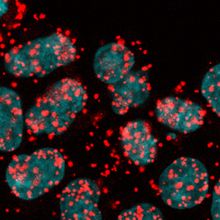cancer genomics

Measuring Mutagenesis with Precision Genome Editing
Deanna MacNeil, PhD | May 3, 2024 | 5 min read
A new prime editing sensor library targeting p53 mutations allowed scientists to interrogate thousands of tumor genotypes as they arose in endogenous contexts.

The Largest Whole-genome Sequencing Study in Cancer
Danielle Gerhard, PhD | Apr 17, 2024 | 7 min read
Comprehensive genome sequencing of 13,880 tumors revealed somatic and germline mutations that could influence patient treatment and prognosis.

Defining the Triple Negative Breast Cancer Morpholome
The Scientist Staff | Feb 21, 2024 | 1 min read
Learn how researchers take a phenotype-first approach to uncover hidden metastatic drivers at tissue and cellular levels.

The Evolution of Bats’ Super Immunity
Niki Spahich, PhD | Jan 10, 2024 | 4 min read
Researchers generated complete genomes of two important bat species and explored their immune- and cancer-related genes.

Epigenetic Changes Drive Cancer
Rebecca Roberts, PhD | Nov 28, 2023 | 3 min read
An analysis of almost 700 different tumors revealed that DNA methylation drives tumorigenesis just like genetic mutations do.

Integrate and Innovate with NGS and Multiomics
The Scientist and Illumina | May 4, 2023 | 6 min read
Researchers across disciplines combine layers of discovery obtained with accessible NGS-based multiomics approaches.

Overcoming Genomic Analysis Challenges for Cancer Research
Oxford Nanopore Technologies | May 2, 2023 | 1 min read
Researchers advance the potential of precision medicine with cutting edge sequencing technology.

Mutated Cohesin Throws DNA Splicing out of Whack, Resulting in Cancer
Shafaq Zia | Mar 3, 2023 | 2 min read
Cohesin mutations cause dysregulations in alternative splicing, contributing to tumor initiation and progression, a study finds.

Mutational Signature Indicates Risk of Kidney Cancer Recurrence
Holly Barker, PhD | Mar 1, 2023 | 2 min read
DNA sequencing can identify mutations that predict recurrence of renal cell carcinoma and may help low-risk patients avoid unnecessary treatment, a study finds.

Understanding How Single Cell Evolution Drives Tumor Complexity
The Scientist | Feb 23, 2023 | 1 min read
Andris Abramenkovs and Mark Lynch will discuss how to overcome challenges obtaining high-definition genomic data from single cells.

Jumping Genes Put a Target on Cancerous Cells
Natalia Mesa, PhD | Feb 14, 2023 | 4 min read
Two studies find that tumor-specific antigens are often peptides that result from a splicing event between exons and transposable elements.

2022 Top 10 Innovations
The Scientist | Dec 12, 2022 | 10+ min read
This year’s crop of winning products features many with a clinical focus and others that represent significant advances in sequencing, single-cell analysis, and more.

Phenotypic Variation in Cancer Cells Often Not Due to Mutations
Jef Akst | Oct 26, 2022 | 3 min read
Most differences in gene expression among cells within a tumor are likely due to environment or noise, a study suggests.

Internal Clock Disruptions Increase Colon Cancer Risk in Mice
Shafaq Zia | Aug 19, 2022 | 3 min read
Disturbing circadian rhythms in organoids and mice increases intestinal tumor growth, findings that may explain a recent rise in colon cancer among young adults, the researchers behind the work say.

Underdog Enzyme Likely Responsible for Mutations in Most Cancers
Sophie Fessl, PhD | Jul 28, 2022 | 3 min read
A previously overlooked enzyme called APOBEC3A is linked to the most prevalent mutational signatures in cancer cell lines, a study finds.

Multi-Gene Panels in Hereditary Cancer: Cause for Caution?
Qiagen | Jul 14, 2022 | 1 min read
Learn where scientists need to exercise awareness when interpreting next-generation sequencing data for cancer screening.

Genetic Mutations Can Be Benign or Cancerous—a New Method to Differentiate Between Them Could Lead to Better Treatments
Ryan Layer, The Conversation | May 27, 2022 | 5 min read
Tumors contain thousands of genetic changes, but only a few are actually cancer-causing. A quicker way to identify these driver mutations could lead to more targeted cancer treatments.

Study Nearly Doubles Known Cancer-Linked Mutational Signatures
Jef Akst | Apr 22, 2022 | 2 min read
Analyzing the whole genome sequences of more than 18,000 tumors, researchers catalog nearly 60 new patterns of mutations that could inform cancer treatment.

Assigning Meaning: Genetic Variant Interpretation in Hereditary Cancer
Qiagen | Jan 19, 2022 | 1 min read
Improving the reliability of genetic variant annotation and clinical interpretation
